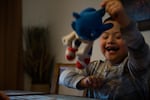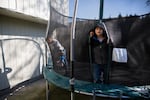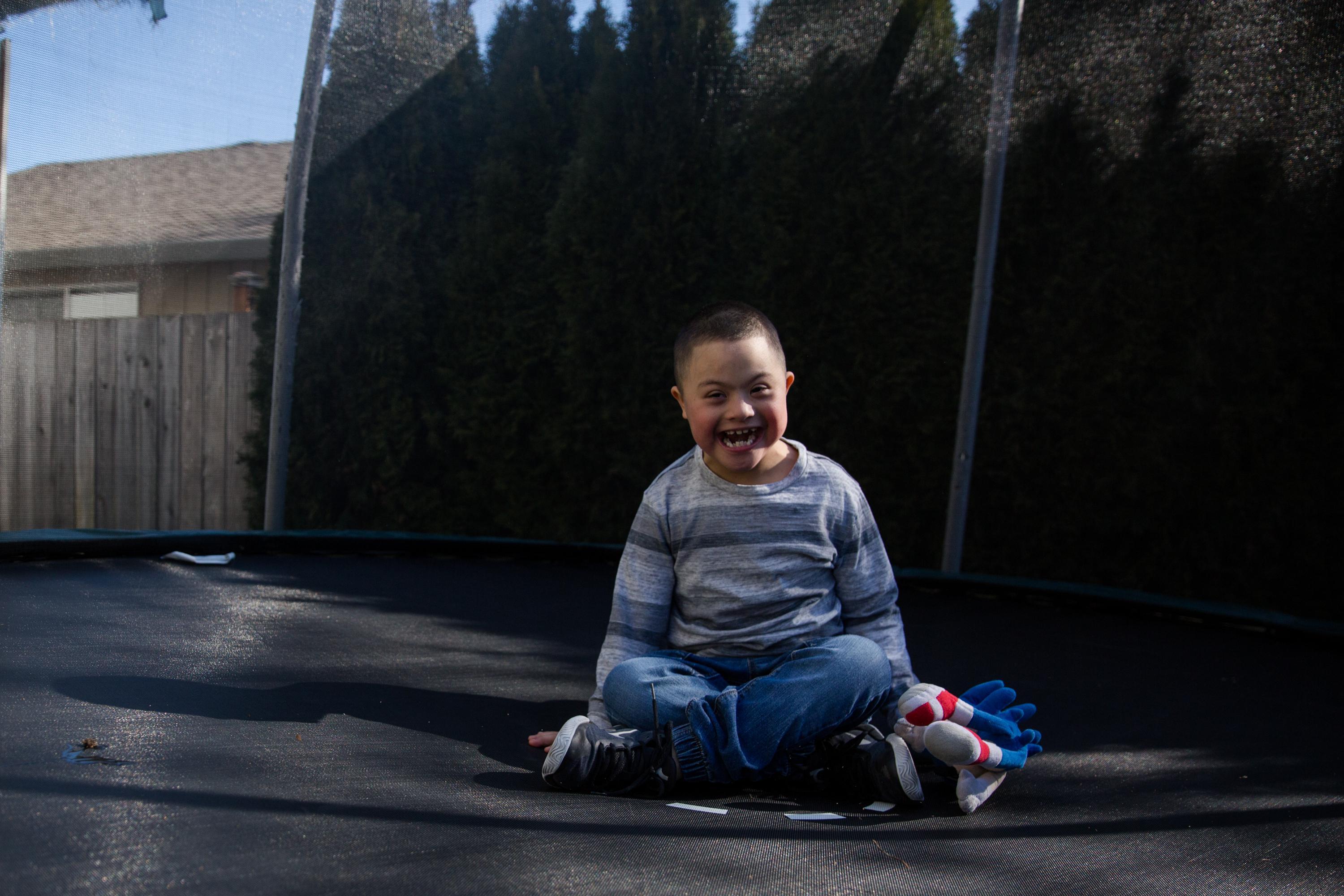One day last October, Raquel Rosales arrived to pick her son Romeo up at school and found him in a classroom by himself wearing diapers.
Rosales was shocked. Romeo, a 7-year-old with a big smile, has Down syndrome. But he can go to the bathroom by himself.
After she got Romeo in the car to go home, she recorded herself asking him questions. She pointed the camera over her shoulder at Romeo in his car seat.
“I want you to tell me why you were in that room,” she said, carefully pronouncing each word for her son.
READ PART 2: Vancouver Parents Sue, Settle Over Restraint And Isolation Of Disabled Children
READ PART 3: Changing The System Of Restraint And Isolations Won't Be Easy
“Why were you in the room by yourself, when I went to pick you up in school? Did you want to go watch TV, like the other kids were watching TV?” Rosales asked, recalling that she’d seen Romeo’s classmates watching a video when she was looking for him.
“Yeah,” her son responded. As he answered, he played with a plastic mask, spinning it by the strap.
She asked again if Romeo wanted to be with his classmates. Again, he responded with a simple, “Yeah.”
“Why did they put you in the dark room?” Rosales asked, referring to the separate space where she found her son.
Romeo said he didn’t know. Neither did she.

Romeo, 7, swings a stuffed Sonic the Hedgehog in his family home in Vancouver, Wash., Saturday, March 2, 2019. Romeo has Down syndrome and his family has struggled to find adequate care from schools in southwest Washington.
Bradley W. Parks / OPB
Thousands of times in the last few school years, students in Oregon and Washington have been physically restrained or isolated away from classmates. Such steps are meant to be a last resort used only when children are endangering themselves, other students or school staff.
“The educators I would say, across the board, don’t want children to be restrained,” said Joel Nixon, a social worker with Oregon’s Clackamas Education Service District who has worked with children with significant disabilities for 20 years, including the time he spends consulting other educators.
“They’re in a difficult situation, when they have a large class size and a small number of staff, to support children with challenging behaviors.”
Parents also contend that educators often restrain or seclude students when it’s not necessary to maintain safety.
Parents Say They Aren't Told
Schools are required to report all restraints and seclusions, and thousands are documented in the Pacific Northwest every year. But many incidents are not reported, and often parents say they don’t learn about them until long after. The vast majority involve students with disabilities, many of them who struggle to communicate what they're experiencing, leaving parents to wonder what’s happening to their children — and the children to wonder why their parents aren’t helping.
“They never reported to me before that they were doing that to him,” Rosales said of the day she discovered Romeo in an isolation room at Silver Star Elementary in southwest Washington’s Evergreen school district.
“Even that day, they did not report it to me, for how long was my son there, or why he was put in there.”

Romeo, 7, left, and his brother Rey play on the trampoline in the backyard of their family home in Vancouver, Wash., Saturday, March 2, 2019.
Bradley W. Parks / OPB
Educators say restraining or secluding a child can protect their safety and even calm them when done properly. They say they try to limit such techniques to when it’s necessary for safety.
Parents and educators agree that repeated restraints and seclusions can be traumatic physically and psychologically, both short and long-term. Laws in Oregon and Washington require parent notification, in part so that parents can help mitigate the harm to children, and so they can collaborate with school staff on a better approach for the student. When parents don’t know for a prolonged period of time, the child’s problems can build.
Related: Disparities Persist In School Discipline, Says Government Watchdog
Raquel Rosales says Romeo was being isolated repeatedly, and it was making him fear school. She said he started resisting going to school. She says Romeo would even force himself to vomit, shortly after getting to school — or even on the bus — so he could go home.
Rosales learned early this school year that Romeo was being isolated, and it’s still not clear to her that there was any safety reason for it.
For other families, it can take months to find out what’s happening to their child.
Back in 2014, Nick and Patty Vervair recall their 7-year-old was getting ready for second grade. The boy liked cars and video games. But as a youngster on the autism spectrum, he could get overstimulated. So his dad talked to a teacher at his son’s school, Sacajawea Elementary in Vancouver, about where his son could go to calm down once school began.
“I asked to see it, you know, 'Where do you put them for their time-outs, or breaks, or whatever?'” Vervair said. “And she walked me over, and she showed me this room, and it was open with no doors. It was how I would want it to be.”
But it turned out he wasn't seeing the classroom his son would end up attending. Instead of open space, the boy's class had a padded closet. Adults could close students inside, and observe them through a window. Their son didn’t know his parents were unaware, and for months they encouraged him to use a calm-down space they hadn’t seen.
“I just keep coming back to that, but man it pissed us off,” Nick Vervair said with an exasperated sigh.
The Vervairs went almost the entire school year before they learned that their son was being secluded in that small, closed room. They found out from another child’s therapist.
“She asked us ‘Well, what are those reports saying?,'” Vervair said.
“And we’re like ‘What reports?’ Because we never got any of those.”
Consequences Of Not Knowing
Vervair recalls going to the district office and asking for the reports, which summarized numerous seclusions on 17 different days, including one lasting 2 hours.
Those reports helped explain changes in their son’s behavior over that school year, Vervair said. In second grade, the boy was less happy, even sullen. Handwritten notes from teachers outlined threats the boy was making.

Nick Vervair sits on his couch looking over school records for his son. His boy was put in isolation at school on 17 different days in the 2014-15 school year, without the family knowing.
Rob Manning / OPB
“After lunch, he was doing math, he was not angry or upset, but he suddenly pointed his fingers at another student, as if they were guns, and told him he was going to shoot and kill him and everyone in the school,” one note from a teacher said.
“[He] continued to point his fingers at the student and say he was going to hurt people.”
Neither Vancouver nor Evergreen school districts would comment on specific students, even with the permission of the children’s parents. Vancouver’s executive director of special services, Daniel Bettis, discussed policies over special education and approaches to restraint and isolation. He said that when administrators learn about problems, they investigate.
Related: Life And Death At Chemawa Indian School
“When we’re made aware of the fact when that process is not being followed, we certainly follow-up and investigate those, and then we provide any necessary remedy to ensure we are in compliance,” Bettis said.
The district allowed the Vervairs to change their son’s school, and in 2016-17 — the last year for which there is data available — Sacajawea reported no isolation incidents.
The Vervairs said Vancouver officials assured them they were phasing out the use of “resolution rooms,” as the district calls them. But this year, Vancouver officials said they still used 14 of them, though officials said they’re moving toward removing doors from them.
Washington publishes, down to the school level, how often restraint and isolation incidents take place. Oregon collects information only at the district level and doesn’t publish it.
Similar Objections In Oregon
Parents in Oregon have many of the same concerns as they do in Washington — that isolation and restraint are used too often, in situations that aren’t dangerous, and that parents aren’t informed.
Kelli Taylor’s stepdaughter Lilli is a fifth grader in the Salem-Keizer Public Schools, Oregon’s second largest district.
“She is so happy-go-lucky and an amazing clown,” Taylor said of Lilli, a high-functioning kid on the autism spectrum.
“She will do anything to try to get a laugh out of you, even if it’s not necessarily the most appropriate thing.”
Lilli also has oppositional defiant disorder, often characterized by irritability and a tendency to argue.
Taylor said kindergarten and first grade went fine for Lilli. Three years ago, Lilli clashed with her second-grade teacher and changed to a new school and a specialized classroom for kids with disabilities. The family was skeptical of the new arrangement, and over the years, Taylor said Lilli would repeatedly observe teachers restraining or isolating her classmates.
The most serious incident involving Lilli happened three months ago.
Taylor remembers Lilli coming home with finger-shaped bruises on her arms. She was also black and blue on her lower legs, and the bruises extended down below where she'd been wearing boots.

Lilli, a fifth grader in Salem-Keizer Public Schools, folds her arms to show small bruises the family said came from school staff members restraining her.
Courtesy of Kelli Taylor
Lilli told her stepmother she'd been in an evaluation that wasn’t going well, with Lilli becoming increasingly defiant. Taylor said staffers “triggered” Lilli with non-verbal directions, which she says Lilli took as an overly childish approach. Taylor suspects Lilli may have started yelling and refusing to cooperate.
“From what I’ve heard, from what Liili has told me, they got her outside of her normal classroom at one end of the building and got her to a secondary classroom, which is about 100 feet away,” Taylor said.
Taylor said in talking to Lilli, and seeing her injuries, it was pretty clear what happened next.
“If she was already frustrated, she wouldn’t have been willing to go, so more than likely, they would have had to compel her to move a certain way,” Taylor said.
Taylor said the staff got Lilli into the other classroom, where they used big, blue gymnastics mats to keep her in place.
“And in doing so, [they] were body-slamming her, as she put it,” Taylor said.
“She ended up getting pushed against a wall with a coat hook on it, and it got shoved into her back — nearly two months later, and she still [had] a mark on her back.”
The Salem-Keizer district declined to comment, as administrators were entering mediation talks with Lilli’s family this winter. According to the district’s records, Salem-Keizer educators have physically restrained students more than 600 times in each of the last three school years. That’s more than three times a day, every school day.
Nixon, the social worker at the Clackamas Education Service District, notes that the use of isolation in Oregon is pretty rare. Restraint is more common.
Nixon is the go-to person for the Oregon Education Association, the statewide teachers’ union, when it comes to issues such as restraint, isolation and students with disabilities. But he acknowledges that restraints often result from educators reacting emotionally to a student who’s starting to get out of control.
Related: Oregon Sued Over Instruction Time For Students With Disabilities
“Sometimes there’s a misperception that kids are acting out aggressively because they want to,” Nixon said.
Parents and educators sometimes say that “behavior is communication,” when children with disabilities struggle to interpret social cues or new situations.
Children may be trying to communicate, but teachers point out that they’re often hurt when students start acting out physically. But parents and educators acknowledge that it can be hard for school staff to remain calm, and not get frustrated, as children get out of control.
Nixon said it’s even more basic than that. He says children’s fight-or-flight instincts take over, especially kids who’ve been traumatized previously.
“Sometimes ... behavior is survival,” Nixon said.
This story is the first of a three-part series about Oregon and Washington students being restrained or isolated from their peers. You can read part two here and part three here.

